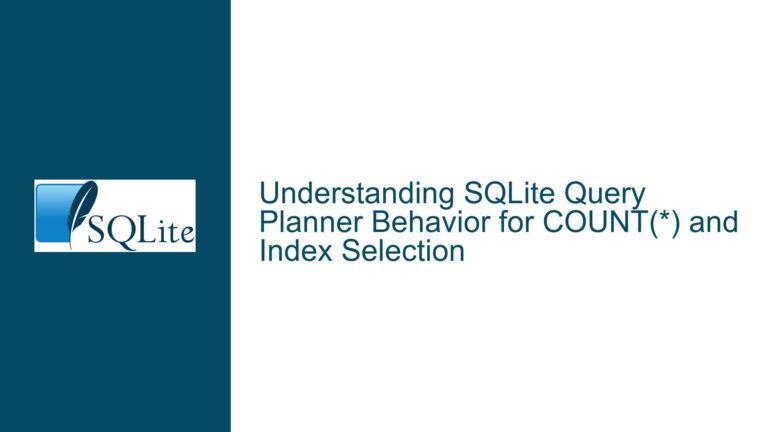SQLite Multi-Threaded Assertion Errors and Segfaults with TEMP TRIGGER on Non-Temp Tables
SQLite Assertion sqlite3BtreeHoldsMutex Failure and Random Segfaults in Multi-Threaded Environments
The core issue revolves around SQLite’s behavior in multi-threaded environments when a CREATE TEMP TRIGGER statement is executed on a non-temporary table. The problem manifests as an assertion failure in SQLite 3.31.1, random segmentation faults in SQLite 3.32.1, and consistent segmentation faults in SQLite 3.33.0. The assertion failure specifically occurs in the sqlite3BtreeHoldsMutex function, which is designed to ensure that the B-tree mutex is held when required. The segmentation faults appear to be related to memory access violations, often involving functions like sqlite3DbMallocRawNN, sqlite3ExprDeleteNN, and sqlite3VdbeMemTranslate. These issues disappear when the CREATE TEMP TRIGGER statement is commented out, suggesting a strong correlation between the trigger creation and the observed errors.
The multi-threaded environment introduces additional complexity, as the application uses a global static mutex to regulate write access to the database, while relying on SQLite’s internal mechanisms to handle concurrent read access. The Write-Ahead Logging (WAL) mode is enabled, which is generally well-suited for concurrent read and write operations. However, the presence of a temporary trigger on a non-temporary table appears to disrupt SQLite’s internal synchronization mechanisms, leading to the observed assertion failures and segmentation faults.
Interplay Between Temporary Triggers, Custom Functions, and Multi-Threaded Access
The root cause of the issue appears to be a combination of factors involving temporary triggers, custom SQL functions, and multi-threaded access patterns. Temporary triggers in SQLite are designed to exist only for the duration of the database connection that creates them. When a temporary trigger is created on a non-temporary table, it introduces a dependency between the temporary schema (specific to the connection) and the non-temporary schema (shared across connections). This dependency can lead to race conditions in multi-threaded environments, especially when the trigger invokes custom SQL functions.
Custom SQL functions, such as some_func() in the provided example, are registered using sqlite3_create_function. These functions are executed within the context of the trigger, and their behavior can influence SQLite’s internal state. If the custom function performs operations that are not thread-safe or interacts with shared resources in an unsafe manner, it can lead to memory corruption or synchronization issues. In the provided case, the custom function performs logging (e.g., printf), which may not be inherently thread-safe depending on the implementation.
The multi-threaded environment exacerbates these issues by introducing concurrency. While the application uses a global static mutex to regulate write access, this mutex does not protect against all potential race conditions, particularly those involving internal SQLite structures. The WAL mode, while generally robust, does not eliminate all synchronization challenges, especially when temporary triggers and custom functions are involved.
Diagnosing and Resolving Multi-Threaded SQLite Issues with Temporary Triggers
To address the assertion failures and segmentation faults, a systematic approach is required to diagnose and resolve the underlying issues. The following steps outline a comprehensive troubleshooting process:
Step 1: Verify Thread Safety of Custom Functions
The first step is to ensure that all custom SQL functions registered with sqlite3_create_function are thread-safe. This includes verifying that any shared resources accessed by these functions are properly synchronized. For example, if the custom function performs logging using printf, ensure that the logging mechanism is thread-safe or protected by appropriate synchronization primitives.
Step 2: Isolate the Impact of Temporary Triggers
To isolate the impact of temporary triggers, create a minimal reproducible example that replicates the issue. This involves creating a simplified version of the application that includes only the essential components necessary to trigger the error. For example:
CREATE TABLE test_table (id INTEGER PRIMARY KEY, value TEXT);
CREATE TEMP TRIGGER test_trigger AFTER INSERT ON test_table
BEGIN
SELECT some_func();
END;
Run this simplified example in a multi-threaded environment to confirm that the issue persists. If the issue is reproducible, proceed to the next step.
Step 3: Analyze SQLite’s Internal Synchronization
Use debugging tools such as gdb or AddressSanitizer to analyze SQLite’s internal synchronization mechanisms. Focus on the sqlite3BtreeHoldsMutex assertion and the memory access violations identified in the stack traces. Pay particular attention to the interaction between the temporary trigger, the custom function, and SQLite’s internal mutexes.
Step 4: Modify Trigger and Function Implementation
Modify the temporary trigger and custom function implementation to reduce the likelihood of race conditions. For example, consider the following changes:
- Replace the temporary trigger with a non-temporary trigger if the use case allows.
- Ensure that the custom function does not perform any non-thread-safe operations.
- Use SQLite’s built-in functions (e.g.,
datetime()) instead of custom functions to see if the issue persists.
Step 5: Update SQLite Version and Configuration
Ensure that the latest stable version of SQLite is being used, as newer versions may include fixes for related issues. Additionally, review the SQLite compilation options to ensure that thread safety is properly enabled. For example, verify that THREADSAFE=1 is set and consider enabling additional debugging options such as SQLITE_DEBUG and SQLITE_ENABLE_EXPENSIVE_ASSERT.
Step 6: Implement Robust Error Handling
Implement robust error handling in the application to detect and recover from potential issues. This includes checking the return values of SQLite API calls and using SQLite’s error codes to identify and address problems. For example:
int rc = sqlite3_exec(db, "INSERT INTO test_table (value) VALUES ('test');", NULL, NULL, NULL);
if (rc != SQLITE_OK) {
fprintf(stderr, "SQL error: %s\n", sqlite3_errmsg(db));
}
Step 7: Conduct Stress Testing
Conduct stress testing in a multi-threaded environment to validate the changes and ensure that the issue is resolved. Use tools such as ThreadSanitizer to identify any remaining synchronization issues.
By following these steps, the assertion failures and segmentation faults can be systematically diagnosed and resolved. The key is to carefully analyze the interaction between temporary triggers, custom functions, and SQLite’s internal synchronization mechanisms in a multi-threaded environment.
| Step | Action | Expected Outcome |
|---|---|---|
| 1 | Verify thread safety of custom functions | Ensure no thread-safety issues in custom functions |
| 2 | Isolate the impact of temporary triggers | Reproduce the issue in a minimal example |
| 3 | Analyze SQLite’s internal synchronization | Identify synchronization issues in SQLite |
| 4 | Modify trigger and function implementation | Reduce likelihood of race conditions |
| 5 | Update SQLite version and configuration | Ensure latest fixes and proper thread safety |
| 6 | Implement robust error handling | Detect and recover from potential issues |
| 7 | Conduct stress testing | Validate changes and identify remaining issues |
This comprehensive approach ensures that the root cause of the issue is identified and addressed, leading to a stable and reliable multi-threaded SQLite application.






